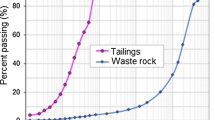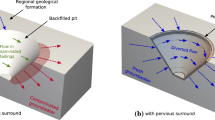Abstract
Co-disposition of tailings and waste rocks in open pits in the form of a permeable envelope and/or waste rock inclusions (WRI) can efficiently prevent the transport of contaminants to the environment. Such drainage paths could also accelerate tailings consolidation rate, similarly to WRI in tailings storage facilities, and therefore improve tailings mechanical properties in the short term and maximize the volume of mine waste that can be disposed of. These geotechnical benefits have, however, not been demonstrated yet nor thoroughly investigated. In this research, three-dimensional models were performed to examine the evolution of tailings consolidation in pits under the influences of co-disposed waste rocks. Various disposal scenarios were investigated, including the presence of a permeable envelop only and the addition of WRI as a central inclusion. The influences of operational and practical aspects such as the tailings filling rate, pit slope angles, waste rock and tailings hydro-geotechnical properties, and pit morphology were investigated. Results indicated that a permeable envelope could promote the dissipation of excess pore water pressure (PWP) and accelerate tailings consolidation. The influence zone of the permeable envelope was relatively limited and around 2 times the tailings height. Using a WRI combined with a permeable envelope could be geotechnically beneficial for wide pits whose radius was larger than twice of its depth. Slope angles, filling rate and pit morphology somewhat affected tailings consolidation rate, but their effect was relatively limited and decreased with the increase in the distance to the drainage paths.












Similar content being viewed by others
Data Availability
Enquiries about data availability should be directed to the authors.
References
Abdulnabi A, Amoako K, Moran D, Vanadara K, Aldaeef AA, Esmaeilzadeh A, Simms P (2022) Evaluation of candidate polymers to maximize geotechnical performance of oil sands tailings. Can Geotech J 59(3):359–371. https://doi.org/10.1139/cgj-2020-0714
Agapito LA, Bareither CA (2018) Application of a one-dimensional large-strain consolidation model to a full-scale tailings storage facility. Miner Eng 119:38–48. https://doi.org/10.1016/j.mineng.2018.01.013
ASTM D2487-17 (2017) Standard practice for classification of soils for engineering purposes (Unified Soil Classification System). In West Conshohocken, Pa: ASTM International.
Aubertin M (2013) Waste rock disposal to improve the geotechnical and geochemical stability of piles. In: Paper presented at the 23rd World Mining Congress, Montreal, Canada
Aubertin M, Bussière B, Pabst T, James M, Mbonimpa M (2016) Review of reclamation techniques for acid generating mine wastes upon closure of disposal sites. In: Paper presented at the Geo-Chicago 2016, Chicago, Illinois, USA
Bhuiyan I, Azam S, Landine P (2015) Consolidation behavior of a uranium tailings storage facility in Saskatchewan. J Hazard, Toxic, Radioact Waste 19(4):040150051–040150057. https://doi.org/10.1061/(ASCE)HZ.2153-5515.0000281
Blight GE (2010) Geotechnical engineering for mine waste storage facilities. CRC Press, Boca Raton
Bolduc F, Aubertin M (2014) Numerical investigation of the influence of waste rock inclusions on tailings consolidation. Can Geotech J 51(9):1021–1032. https://doi.org/10.1139/cgj-2013-0137
Boudrias G (2018) Évaluation numérique et expérimentale du drainage et de la consolidation de résidus miniers à proximité d'une inclusion de roches stériles. (Mémoire de maîtrise), École Polytechnique de Montréal
Bussière B (2007) Colloquium 2004: hydrogeotechnical properties of hard rock tailings from metal mines and emerging geoenvironmental disposal approaches. Can Geotech J 44(9):1019–1052. https://doi.org/10.1139/t07-040
Cameron H, Dave L (2015) In-pit tailings disposal at langer heinrich—tailings storage facilities in a unique hydrogeological setting. In: Paper presented at the Tailings and Mine Waste Management for the 21st Century Sydney
Chai S, Zheng J, Li L (2023) Kink effect on the stress distribution in 2D backfilled stopes. Geotech Geol Eng 41(5):3225–3238. https://doi.org/10.1007/s10706-023-02434-4
Cui L, Fall M (2016) An evolutive elasto-plastic model for cemented paste backfill. Comput Geotech 71:19–29. https://doi.org/10.1016/j.compgeo.2015.08.013
Essayad K, Aubertin M (2021) Consolidation of hard rock tailings under positive and negative pore-water pressures: testing procedures and experimental results. Can Geotech J 58(1):49–65. https://doi.org/10.1139/cgj-2019-0594
Essayad K, Pabst T, Chapuis RP, Aubertin M (2018) An experimental study of tailings migration through waste rock inclusions. In: Paper presented at the 71st Canadian Geotechnical Conference (GeoEdmonton 2018), Edmonton, AB, Canada
Ferdosi B, James M, Aubertin M (2015) Investigation of the effect of waste rock inclusions configuration on the seismic performance of a tailings impoundment. Geotech Geol Eng 33(6):1519–1537. https://doi.org/10.1007/s10706-015-9919-z
Hustrulid W, Kutcha M, Martin R (2013) Open pit mine planning and design. CRC Press, Boca Raton
Itasca (2021) FLAC3D 7.0 (Fast Lagrangian Analysis of Continua in 3 Dimensions) User Manual
James M (2009) The use of waste rock inclusions to control the effects of liquefaction in tailings impoundments. ( Ph.D. ), École Polytechnique de Montréal, Qc, Canada
James M, Aubertin M (2009) The use of waste rock inclusions in tailings impoundments to improve geotechnical and environmental performance. In: Paper presented at the Tailings and Mine Waste 2009, Banff, Alberta
Jaouhar EM, Aubertin M, James M (2013) The effect of tailings properties on their consolidation near waste rock inclusions. In: Paper presented at the 66th Canadian Geotechnical Conference (GeoMontréal 2013), Montréal, Canada
Larochelle CG, Bussière B, Pabst T (2019) Acid-generating waste rocks as capillary break layers in covers with capillary barrier effects for mine site reclamation. Water Air Soil Pollut 230(3):57. https://doi.org/10.1007/s11270-019-4114-0
Lévesque R (2019) Consolidation des résidus miniers dans les fosses en présence d’inclusions de roches stériles. (Mémoire de maîtrise), Ecole Polytechnic Montreal
Li L, Aubertin M (2009) Horizontal pressure on barricades for backfilled stopes. Part I: fully drained conditions. Can Geotech J 46(1):37–46. https://doi.org/10.1139/T08-104
Maryam, M. (2016). Slope stability analysis of waste rock piles under unsaturated conditions following large precipitations. (PhD Ph.D.), Polytechnique Montreal,
McDonald L, Lane JC (2010) Consolidation of in-pit tailings. In: Paper presented at the Mine Waste 2010, Perth, Australia
MEND (2015) MEND report 2.36.1 in-pit disposal of reactive mine wastes: approaches, update and case study results
Morris PH (2002) Analytical solutions of linear finite-strain one-dimensional consolidation. J Geotech Geoenviron Eng 128(4):319–326. https://doi.org/10.1061/(ASCE)1090-0241(2002)128:4(319)
Nguyen D, Pabst T (2020) Comparative experimental study of consolidation properties of hard rock mine tailings. In: Paper presented at the 73rd Canadian Geotechnical Conference (GeoVirtual 2020), Online
Nguyen ND, Pabst T (2023) Consolidation behavior of various types of slurry tailings co-disposed with waste rock inclusions: a numerical study. Environ Earth Sci 82(2):65. https://doi.org/10.1007/s12665-023-10750-4
Nguyen ND (2022) 3D numerical evaluation of consolidation of tailings co-disposed with waste rocks in open pits (Ph.D. Ph.D.), Polytechnique Montréal, Retrieved from https://publications.polymtl.ca/10564/
Pabst T, Bussière B, Aubertin M, Molson J (2018) Comparative performance of cover systems to prevent acid mine drainage from pre-oxidized tailings: a numerical hydro-geochemical assessment. J Contam Hydrol 214:39–53. https://doi.org/10.1016/j.jconhyd.2018.05.006
Priestley D (2011) Modeling multidimensional large strain consolidation of tailings. (Master), University of British Columbia
Rousseau M, Pabst T (2020) Blast damaged zone influence on water and solute exchange between backfilled open-pit and the environment. In: Paper presented at the 73rd Canadian Geotechnical Conference (GeoVirtual 2020), Online
Rousseau M (2021) Étude numérique de la réduction du transport advectif de contaminants entre les fosses remblayées et l’environnement par l’utilisation de chemins d’écoulements préférentiels. (Ph.D.), École polytechnique Montréal
Rousseau M, Pabst T (2022) Topology optimization of in-pit codisposal of waste rocks and tailings to reduce advective contaminant transport to the environment. Struct Multidiscip Optim 65(6):168. https://doi.org/10.1007/s00158-022-03266-1
Schiffman RL (1982) The consolidation of soft marine sediments. Geo-Mar Lett 2(3–4):199–203. https://doi.org/10.1007/bf02462763
Somogyi F (1980) Large strain consolidation of fine grained slurries. In: Paper presented at the Presentation at the Canadian Society for Civil Engineering, Winnipeg, Manitoba
Townsend FC, McVay MC (1990) SOA: large strain consolidation predictions. J Geotech Eng 116(2):222–243. https://doi.org/10.1061/(ASCE)0733-9410(1990)116:2(222)
Utili S, Agosti A, Morales N, Valderrama C, Pell R, Albornoz G (2022) Optimal pitwall shapes to increase financial return and decrease carbon footprint of open pit mines. Min, Metall Explor 39(2):335–355. https://doi.org/10.1007/s42461-022-00546-8
Vick SG (1990) Planning, design and analysis of tailings dams. BiTech Publishers Ltd, Vancouver, BC
Wickland BE, Wilson GW, Wijewickreme D, Klein B (2006) Design and evaluation of mixtures of mine waste rock and tailings. Can Geotech J 43(9):928–945. https://doi.org/10.1139/t06-058
Acknowledgements
The authors are thankful to the financial support from Fonds de recherche du Québec—Nature et Technologies (FRQNT) (Grant No. 2017-MI-202116) and partners of Research Institute on Mines and the Environment (RIME UQAT—Polytechnique; http://rime-irme.ca/en). The authors also gratefully acknowledge Dr. Huy Tran, Dr. Kazim and Itasca technical support team for their valuable support and comments to improve the code in this study.
Author information
Authors and Affiliations
Contributions
NDN: Conceived and designed the analysis; Collected the data from literature; Performed the numerical simulations; Data curation; Writing—original draft. TP: Conceived and designed the analysis; Developed an approach for analysis of the results; Supervision; Writing—Review & Editing; Funding acquisition.
Corresponding author
Ethics declarations
Conflict of interest
The authors have no relevant financial or non-financial interests to disclose.
Additional information
Publisher's Note
Springer Nature remains neutral with regard to jurisdictional claims in published maps and institutional affiliations.
Rights and permissions
Springer Nature or its licensor (e.g. a society or other partner) holds exclusive rights to this article under a publishing agreement with the author(s) or other rightsholder(s); author self-archiving of the accepted manuscript version of this article is solely governed by the terms of such publishing agreement and applicable law.
About this article
Cite this article
Nguyen, N.D., Pabst, T. Acceleration of Consolidation of Tailings in a Pit Using Waste Rocks Co-disposal. Geotech Geol Eng 42, 1593–1609 (2024). https://doi.org/10.1007/s10706-023-02633-z
Received:
Accepted:
Published:
Issue Date:
DOI: https://doi.org/10.1007/s10706-023-02633-z




